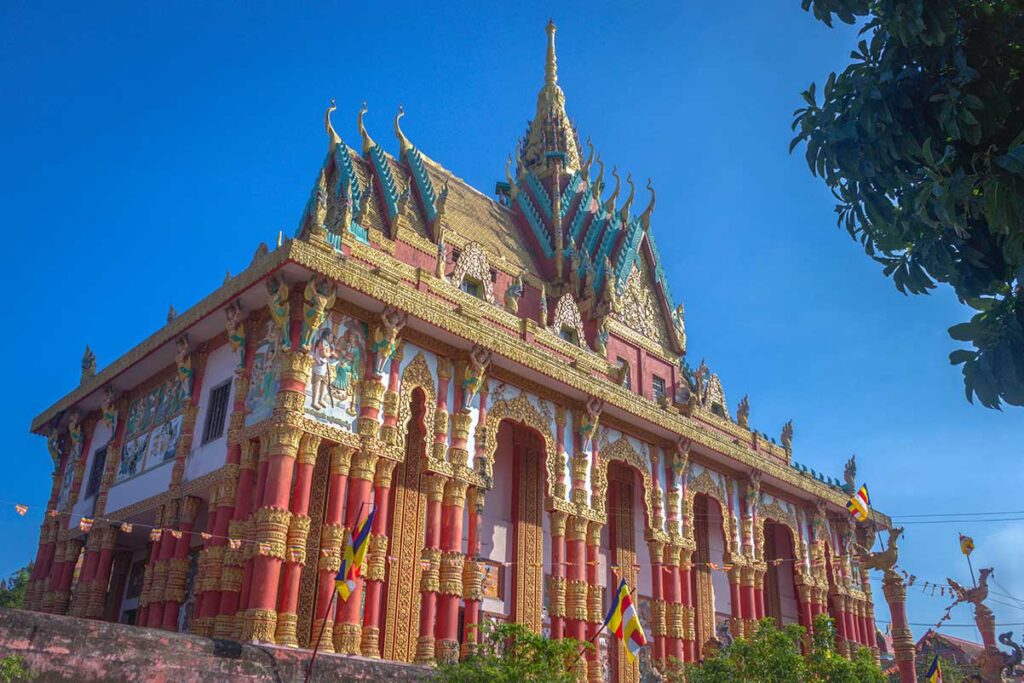What is Ghositaram Temple?
Background and origins
Ghositaram Temple belongs to the Khmer Theravada Buddhist tradition, which is practiced by many Khmer communities across the Mekong Delta. The original temple was built between 1860 and 1872, serving as a spiritual and cultural center for local people. By the late 20th century, the structure had deteriorated, and a major reconstruction project began in 2001. After nearly a decade of work, the new main hall was inaugurated in 2010, combining traditional Khmer design with modern construction techniques.
Cultural role
For the Khmer community in Bac Lieu, Ghositaram Temple is far more than just an architectural site. It is a place of worship, a gathering point during festivals, and an important center of learning. Following Khmer tradition, boys often spend time here as novice monks in their teenage years, both to study Buddhist scriptures and to show respect to their parents. The temple also helps preserve Khmer customs, language, and art, making it a key part of community life.
Today’s role
Today, Ghositaram Temple functions as both an active monastery and a cultural landmark. It remains a living religious space where monks reside and ceremonies take place, while also welcoming travelers who want to learn about Khmer Buddhism and admire its striking architecture. Visitors should keep in mind that it is first and foremost a place of worship, but it is generally open and welcoming to respectful tourists.
Highlights of visiting Ghositaram Temple
1. The Main Hall (Vihara)
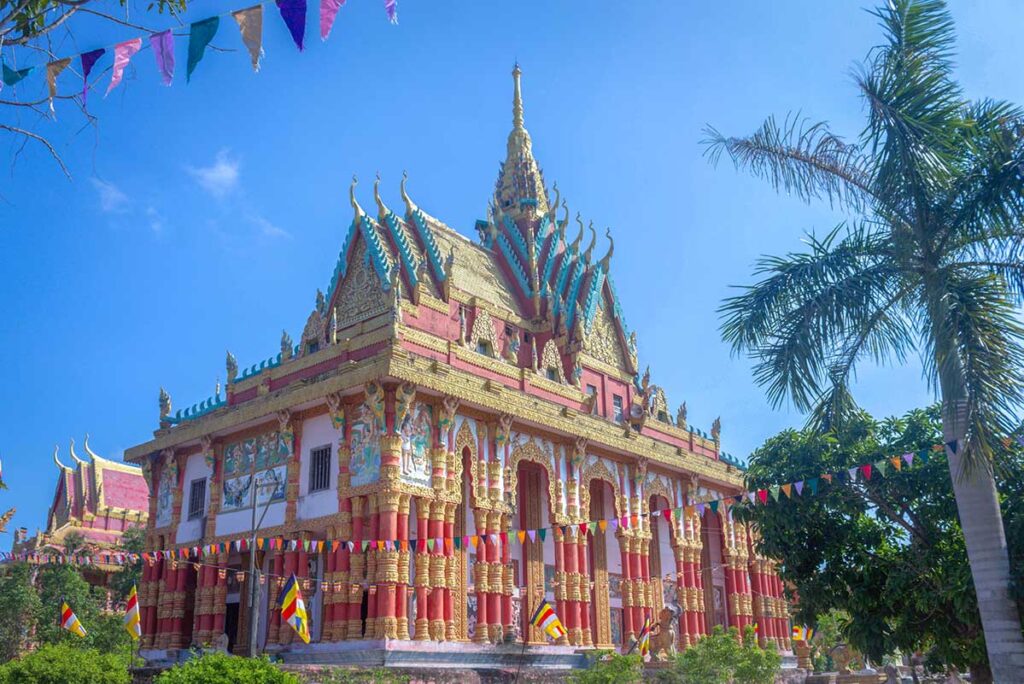
The centerpiece of Ghositaram Temple is its main hall, one of the largest of its kind among Khmer temples in Vietnam, with a surface area of 427 m² and a height of around 36–40 meters.
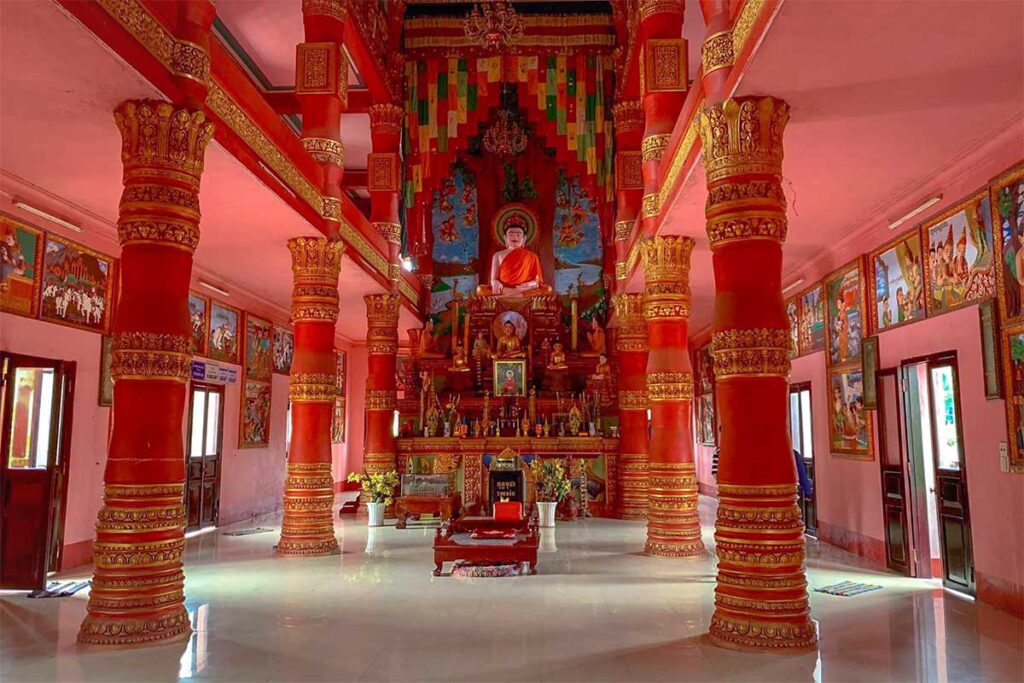
Inside and out, the hall is richly decorated with carvings and murals that tell stories from the Buddha’s life while also showcasing Khmer cultural motifs. Even if you have seen temples in Cambodia or Thailand, the scale and level of detail here are still impressive for the Mekong Delta.
2. Towers and Stupas
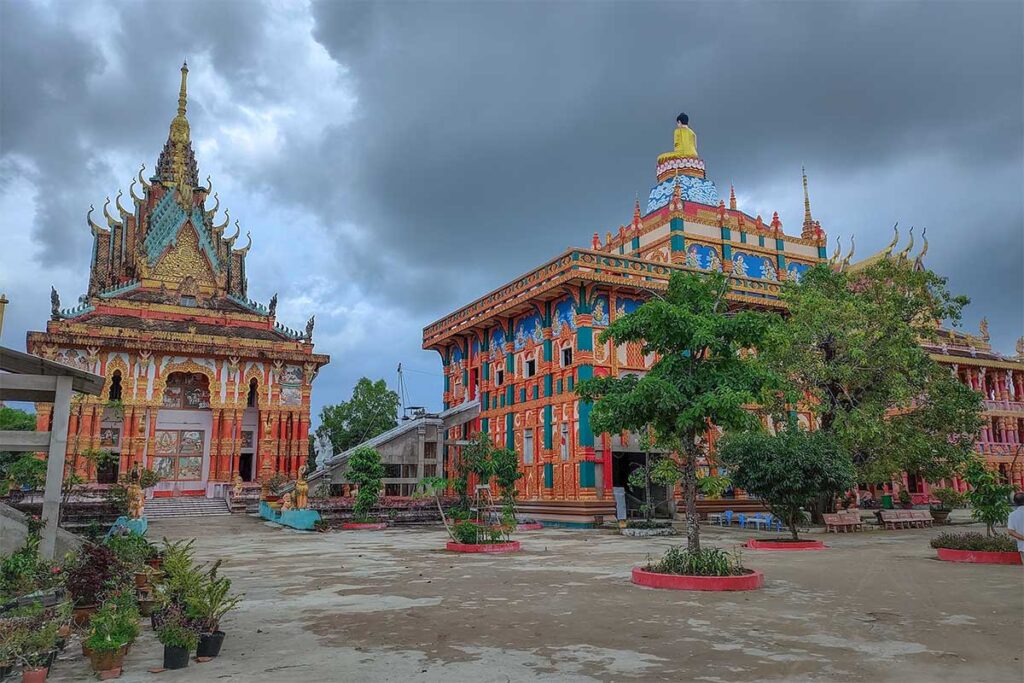
On the temple grounds, two tall stupas preserve the ashes of Buddhists from the local community. These structures are not only sacred but also striking in their decorative detail, with layered roofs and ornate finials that reflect Khmer architectural traditions. They add to the sense of grandeur while reminding visitors that this is an active religious site.
3. Reliefs and Murals
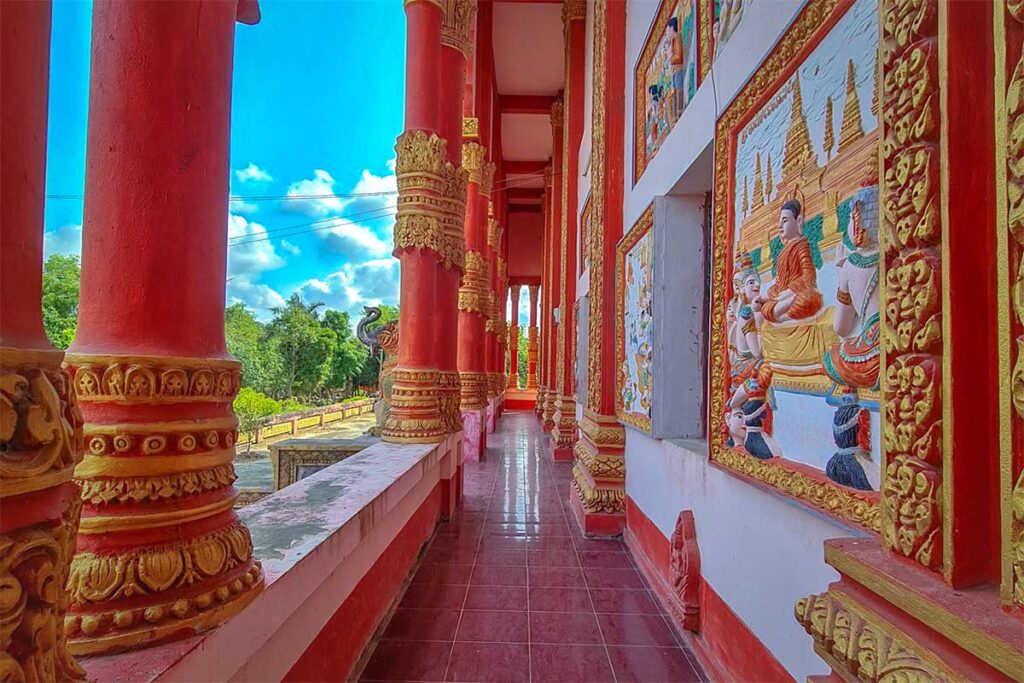
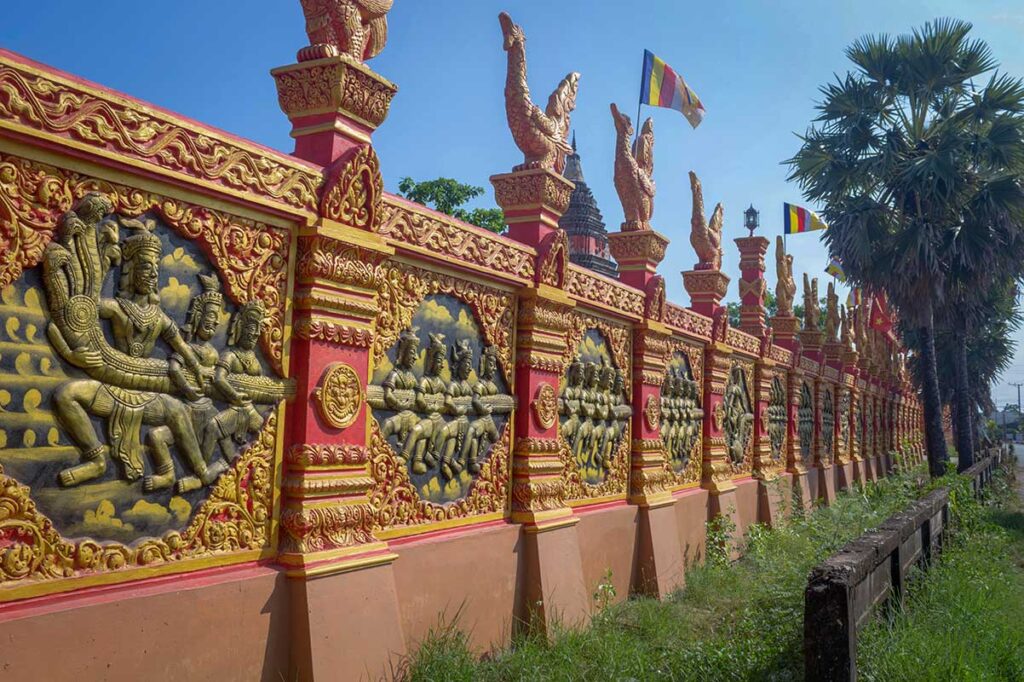
One of the most memorable aspects of the temple is the sheer number of carved reliefs and mural paintings. It is said that artisans spent nearly four years completing the decorations, and when you see the intricacy, that effort makes sense. The carvings tell Buddhist stories in vivid detail, offering a visual journey through key teachings and legends.
4. Khmer Decorative Motifs
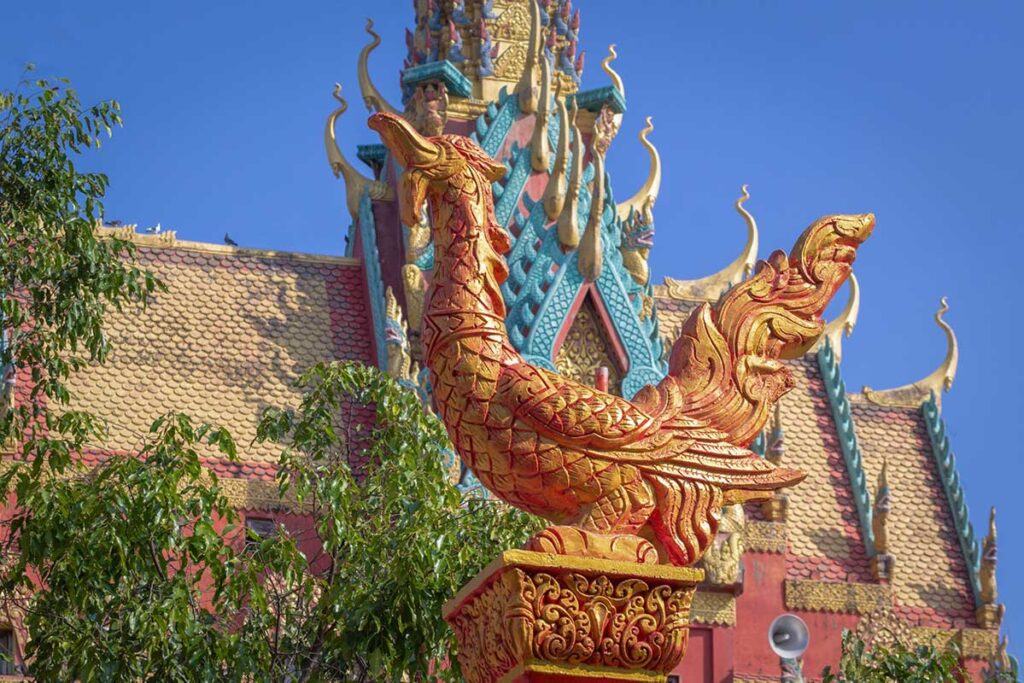
Like many Khmer temples, Ghositaram is full of symbolic details. Dragons, lotus flowers, and curved Angkor-style patterns are found throughout the structure. In Khmer mythology, dragons are believed to transform into boats that help Buddha on his mission to save the world, and these motifs are woven into the architecture with both beauty and meaning.
5. Temple Grounds
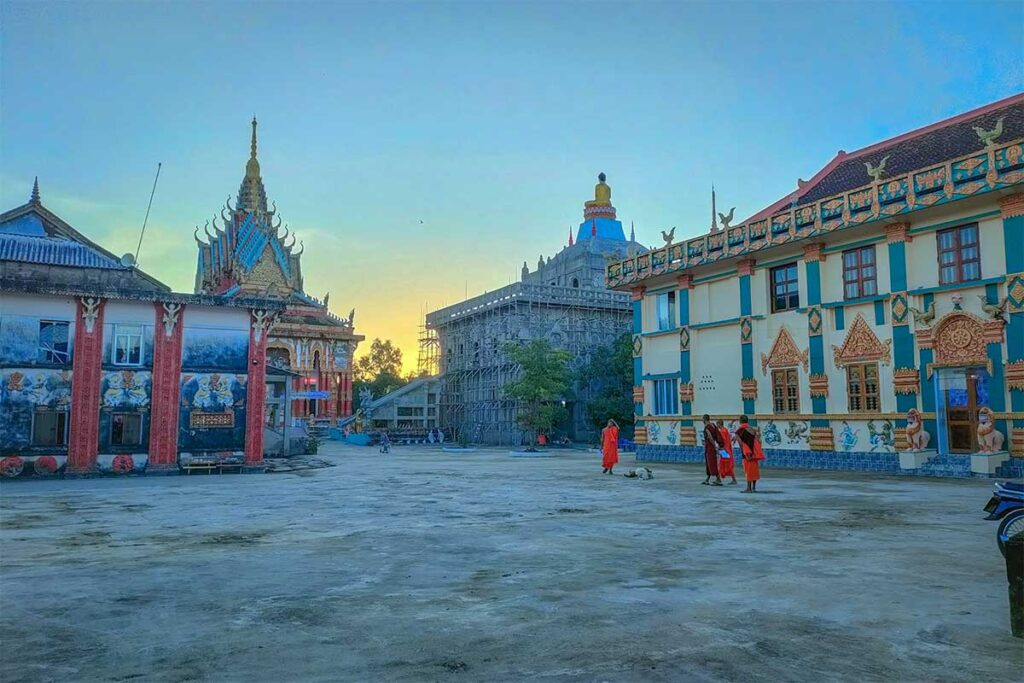
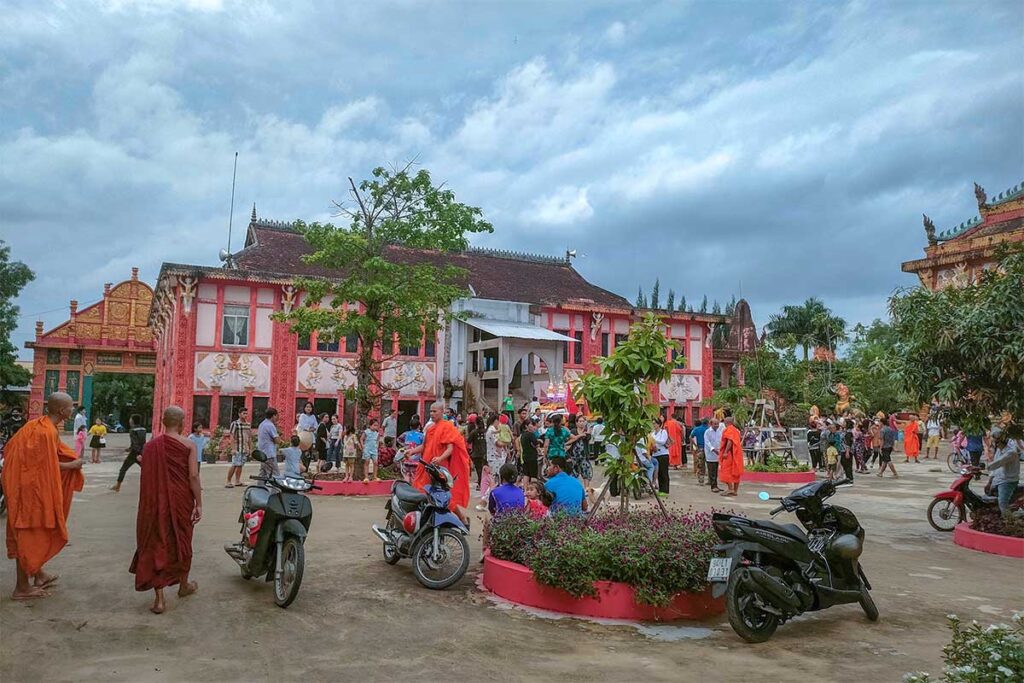
The wider temple grounds are equally atmospheric. A row of tall palm trees marks the entrance, a familiar sight in the Mekong Delta. Colorful flags rise more than 40 meters high, while auxiliary buildings such as a crematorium and lecture halls support the daily life of the monastery. The setting combines monumental scale with a calm, almost meditative atmosphere—pleasant for a short walk after exploring the main hall.
6. Festivals & Community Life
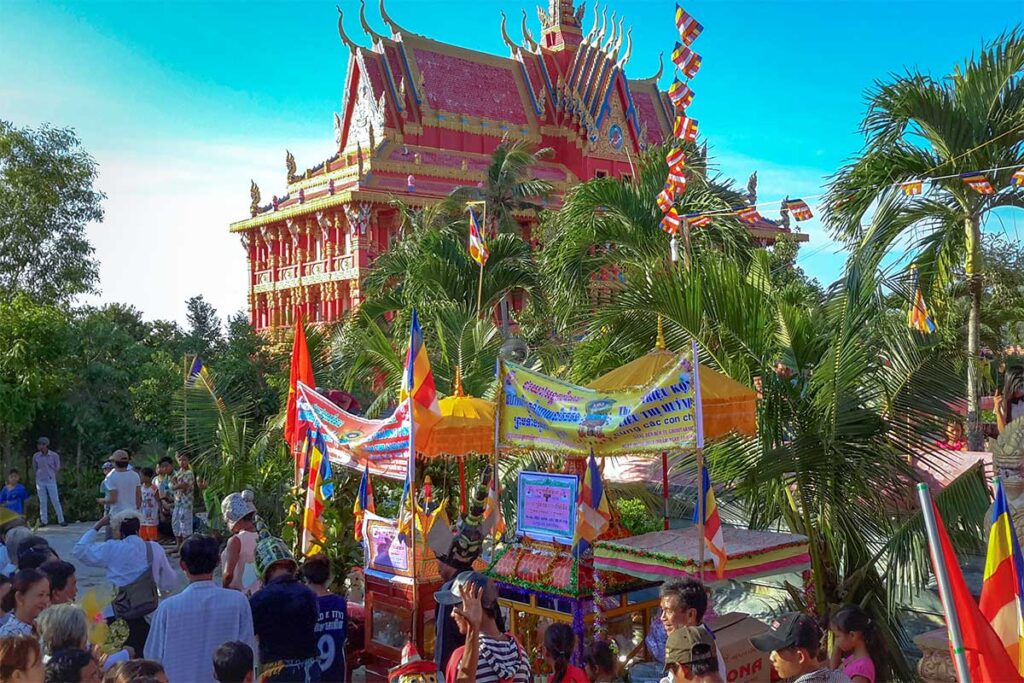
The temple comes alive during Khmer festivals such as Chol Chnam Thmay (Khmer New Year), Dolta (ancestor worship), and Kathina (offering of robes to monks). On these occasions, the grounds are filled with color, rituals, and community gatherings. Another living tradition is the temporary monkhood of Khmer boys, who usually spend time at the temple during adolescence. This gives the temple a dynamic role in preserving Khmer culture and ensures that it remains more than just a tourist attraction.
Location and How to get there
Where is Ghositaram Temple?
Ghositaram Temple is located in Cu Lao hamlet, Hung Hoi commune, Vinh Loi district, just 5 kilometers from Bac Lieu city center. It’s close enough to visit on a short trip from town, and the roads leading there are generally straightforward, though rural in feel.
Base cities & Distances
- Bac Lieu – The nearest base, only about 10–15 minutes by car or motorbike.
- Soc Trang – Around 1 hour away and closer to Ho Chi Minh City, often a practical stop when traveling south.
- Ca Mau – About 2 hours further south; combining Ca Mau and Bac Lieu in one trip is common.
- Can Tho – Roughly 2.5 hours away, with the added convenience of domestic flights from Hanoi, Da Nang, or Ho Chi Minh City.
Transport options in the region
Traveling around the southern Mekong Delta relies mostly on road connections:
- Flights – Can Tho and Ca Mau both have small airports with daily domestic flights, useful if you’re short on time.
- Buses – Long-distance buses, especially sleeper buses, connect Ho Chi Minh City and other Delta towns to Bac Lieu and Soc Trang. These are the most common option for locals and budget travelers.
- Trains – The railway does not reach Bac Lieu or Ca Mau, so this is not a realistic option for visiting the temple.
Getting to the temple
- Private Car – Hiring a private car is the most comfortable option, and not only from Bac Lieu City. Cars can also be arranged from nearby hubs like Soc Trang, Ca Mau, or even Can Tho if you are visiting several Mekong Delta highlights in one trip. This makes it easy to combine Ghositaram Temple with other stops such as Xiem Can Pagoda, the Bac Lieu Wind Farm, or the Bird Sanctuary.
- Private Tour – If you prefer not to handle the logistics yourself, arranging a private tour is another good choice. These usually include transport by car with a driver and can cover multiple Bac Lieu attractions in one day. It’s not about group tours with fixed schedules, but more about flexible, tailor-made itineraries you can set up in advance.
- Motorbike – For independent travelers, riding a motorbike is straightforward. The temple is located right along the main road from Bac Lieu, and Google Maps will get you there without issue. Traffic is light compared to bigger cities, but as always in Vietnam, it’s best if you already have riding experience and a valid license.
Practical visiting information and Tips
Entrance Fee & Opening Hours
There is no entrance fee to visit Ghositaram Temple. It generally opens from early morning until late afternoon, though there are no fixed posted hours. If you want to see the main hall open, aim for daylight hours rather than evening.
Dress Code & Etiquette
Like other Buddhist temples, modest dress is expected. Cover shoulders and knees, and remove hats when entering halls. Always be respectful of monks and avoid interrupting ceremonies. A polite gesture such as a slight bow or clasping your hands together is appreciated.
Photography
Photography is allowed around the grounds and makes for striking shots thanks to the temple’s bold Khmer-style colors and detailed carvings. Inside the main hall, be discreet: avoid flash, and don’t take photos if prayers or rituals are happening.
Facilities
There is a parking area near the entrance, suitable for both cars and motorbikes. Beyond that, facilities are basic. You won’t find cafés or shops on-site, so bring your own water or snacks. The nearest options are back in Bac Lieu City.
Nearby attractions
If you’re making the trip, it’s worth combining the temple with other sites in the region:
- Bac Lieu Bird Sanctuary (11 km) – A wetland reserve popular for birdwatching.
- Bac Lieu Wind Farm (23 km) – Rows of giant wind turbines along the coast.
- Tac Say Church (41 km) – A Catholic pilgrimage site dedicated to Father Diep.
- Other Khmer Temples – Bac Lieu and neighboring Soc Trang both have several Khmer pagodas worth exploring.
Read more about sights and things to do in our Bac Lieu travel guide.
Travel practicalities
English is not widely spoken, so don’t expect guided explanations unless you arrange one in advance. Bring water, sunscreen, a hat, and mosquito repellent, especially in the warmer months. For photography and comfort, mornings and late afternoons are the best times to visit—both for softer light and cooler temperatures.
Is Ghositaram Temple worth visiting?
If you’re interested in Khmer culture, Ghositaram Temple is one of the most impressive examples in Vietnam. Together with the temples in nearby Soc Trang, it shows the strong Khmer Theravada Buddhist heritage of the Mekong Delta. The scale of the main hall and the richness of the carvings make it stand out compared to most other pagodas in the country.
That said, if you have already traveled in Cambodia or Thailand, the architecture here may not feel entirely unique—those countries have countless Khmer temples of a similar style, often on an even grander scale. What makes Ghositaram interesting is less about being “the best temple in Vietnam” and more about how it represents the Khmer community in Bac Lieu today.
In short, it’s worth a stop if you’re visiting Bac Lieu, Ca Mau, or Soc Trang, especially when combined with other local sights such as the Bac Lieu Wind Farm, Bird Sanctuary, or nearby Khmer pagodas. On its own, it may not justify a long detour, but as part of a wider Mekong Delta itinerary, it adds cultural depth and variety.
